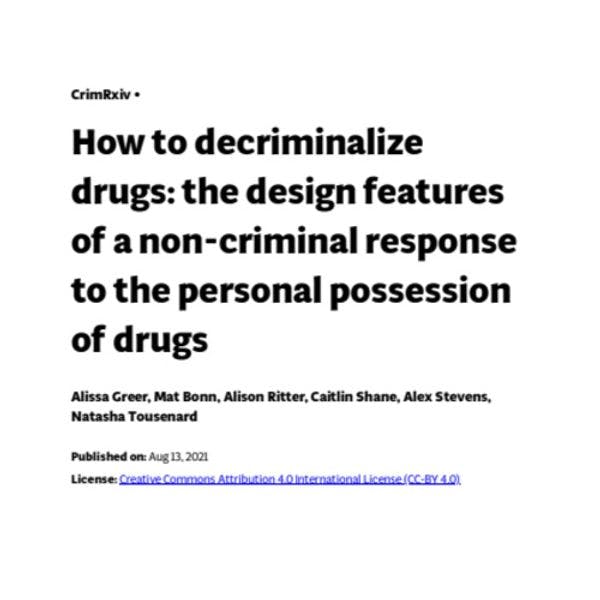Cómo descriminalizar las drogas: características para diseñar una respuesta no penal a la posesión personal de drogas
Greer et al. discuten respuestas no penales a la posesión de drogas a través de tres categorías analíticas: 1) Arquitectura de reformas, 2) criterios de elegibilidad, y 3) acciones emprendidas a partir de la detección de drogas para consumo personal. Más información, en inglés, está disponible abajo.
By Alissa Greer, Mat Bonn, Alison Ritter, Caitlin Shane, Alex Stevens, Natasha Tousenard / crimrxiv
For over 50 years, dozens of countries, states, and cities have implemented varying alternatives to criminal penalties for the personal possession of drugs. The Portugal model is perhaps the most well-known example, although 48 other countries and jurisdictions have removed and/or reduced criminal sanctions related to drug possession, including Mexico, Uruguay, Germany, Lithuania, Australia, Costa Rica, the Czech Republic, and Oregon, USA (Talking Drugs, 2020). Core to these reforms is a greater emphasis on public health, social justice, and human rights, alongside revenue, political, and pragmatic considerations (Global Commission on Drug Policy, 2014; Transform Drug Policy Foundation, 2015).
Several reviews examine the impact of removing or downgrading criminal penalties across jurisdictions, highlighting “tremendous variation in the laws and regulations surrounding so-called decriminalization policies adopted by Western countries” (Pacula et al. (2005) p. 347) and internationally (Eastwood et al., 2016; Hughes et al., 2018; Scheim et al., 2020; Stevens et al., 2019; Unlu et al., 2020). In fact, ‘decriminalization’ is not a singular, uniform approach, but is instead a term that describes myriad legislative models. To simplify the legislative and/or regulatory schemes, Stevens et al. (2019) sort each model into one of three primary classes: decriminalization, depenalization, or diversion. Even so, these scholars and others point out considerable heterogeneity and a lack of articulation regarding the definitions and details under each class (Fischer et al., 2021; Stevens et al., 2019).
Unintended consequences can arise if details of the legislative and/or regulatory model are not adequately considered (Global Commission on Drug Policy, 2016; Rubin, 2012). These can be in terms of the number of people intervened upon (net widening, Cohen 1985) and the intrusiveness of the intervention imposed (net deepening, and/or mesh thinning, Cohen 1985). Net widening happens where a broader population comes under state control under the new regime; net deepening occurs when sanctions are unintentionally more severe for ‘low or shallow end’ offenders who, under the previous regime, would have received lesser punishment; mesh thinning is where alternatives make it relatively harder to get out of the criminal justice system. These consequences are demonstrated globally (Hughes et al., 2016; Roberts & Indermaur, 2006; Stevens et al., 2019). For instance, in Mexico, contact between police and people who use drugs increased as officers had greater leeway to arrest and charge individuals with administrative sanctions (Arredondo et al., 2018; Beletsky et al., 2016). Such consequences demonstrate the importance of good policy design.
The purpose of the current paper is to describe and examine the key design features of non-criminal responses to personal drug possession. We present the features, define the options, and consider their implications. The variety of options available are organized into three categories, below: 1) Reform architecture; 2) Eligibility criteria to which the scheme applies; and 3) Actions taken upon detection of drugs for personal use (see Table 1).
